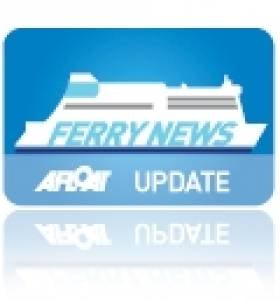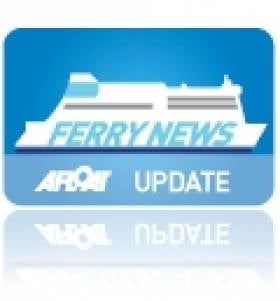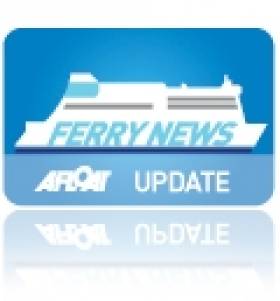Displaying items by tag: Ferry news
High Court Extends Protection for Cork-Swansea Ferry Operators
#FERRY NEWS-A High Court judge has agreed to continue court protection for the companies operating the Cork-Swansea ferry service to allow for finalisation of a survival scheme, reports The Irish Times.
Mr Justice Peter Kelly said yesterday he was satisfied to extend the protection period for the companies to January 24th next.
The extension of time was sought by Declan Murphy, for the companies' examiner Michael McAteer, to allow time for an investment agreement to be signed and a survival scheme put before meetings of creditors.
Fastnet Line Ship Holdings Ltd (100 per cent owned by the West Cork Tourism Co-operative Society Ltd) and related companies operating the ferry service using the M.V. Julia (1981/22,161grt) from the ferry terminal at Ringaskiddy, Co Cork, secured court protection last month.
Later Noel Murphy, chairman of the West Cork Tourism Co-Operative Society, said they had outlined the urgent funding required to secure the future of the service, which will allow them to present a financial proposal to the examiner in early January.
To date €673,000 has been raised by individual donors, customers, shareholders and local businesses, leaving just under €1 million to be raised.
Scottish Ferry Sailings Suffer Storm Disruption
#FERRY NEWS - With winds of up to 100mph, Scottish ferry sailings on the North Channel routes from Northern Ireland, have been affected with two cancellations on Stena's Belfast-Cairnryan services, according to Channel 4 News.
P&O had no reported cancellations on its Irish Sea routes but is advising passengers to check in normally and expect delays. In addition some Scottish domestic ferry services were cancelled on some routes operated by Caledonian MacBrayne, while other services were disrupted.
To read more about the weather disruption across the Scottish central belt remains which remains on-high alert for storms while Northern Ireland and the north of England are subject to a severe weather warning click HERE. For the latest weather visit www.metoffice.gov.uk/
Sailing updates from Stena Line's Belfast-Cairnryan service can be viewed by clicking HERE and for information on delays on Belfast-Liverpool service click HERE. For sailing updates on routes operated by P&O click this LINK.
For the rest of the Irish Sea ferry routes, including those operated by Stena Line and Irish Ferries it would be also advisable to check each route from the operator's websites.
Irish Ferries Dublin Swift fast-ferry sailings to and from Holyhead have been cancelled, though cruiseferry sailings remain operating. To keep updated visit the 24hrs sailing update posted on the homepage of www.irishferries.com and for Irish weather coverage by visiting www.met.ie
Seatruck Newbuild Makes a Fleeting Appearance
#FERRY NEWS-Seatruck Progress (5,300 dwt) the new freight-only ro-ro, due to enter Seatruck Ferries Dublin-Liverpool service this month, as previously reported on Afloat.ie, sailed past Dublin Bay on Tuesday. She continued her overnight delivery voyage to arrive in Liverpool yesterday, fresh from German builders, FGS Flensburg, writes Jehan Ashmore.
As the newbuild approached Dublin Bay, she set a course to the east of the Burford Bank buoys where she continued her voyage to Liverpool, entering the Bootle docks through Langton Lock.
The Douglas registered ro-ro is to be joined by her fleetmate, Seatruck Power on the central corridor service next February. Each of the 21-knot quartet measure 142m long, have a beam of 24m and cater for 2,166 lane freight-metres with the use of an added upper fourth deck.
The increased capacity will enable un-accompanied trailer units to reach 70 on each of the sailings, which are currently served by smaller 'P' series ro-ro's Clipper Point and Clipper Pennant. These vessels were also commissioned by Seatruck from Spanish shipyards and entered servvice several years ago.
Seatruck which is a subsidiary of the Danish-owned Clipper Group, is set to expand the fleet as the Irish Sea's only freight-only operator with a futher pair of the same class from FGS, which are due for delivery in the first-half of 2012. According to Seatruck, these newbuilds are likely to be deployed on the company's other Irish Sea routes.
Seatruck's New Freight-Ferry on Delivery Voyage
#FERRY NEWS-Seatruck Progress (photo), the first of two 18,900 gross tonnes ro-ro newbuilds due to enter on Seatruck Ferries Dublin-Liverpool route, is en -route in the English Channel today from German builders, FGS Flensburg, writes Jehan Ashmore.
Her sister Seatruck Power is due to join her fleetmate on the central corridor service by mid-February. In addition Seatruck have on order another pair of the same class from FGS which are to be completed in 2012 and are likely to be deployed on the company's other Irish Sea routes.
The new quartet each measure 142m and will offer 2,166 lane freight-metres spread over four decks. They will each have a capacity of 150 units, 35 more than Seatruck's current P Series vessels in which Clipper Point and Clipper Pennant are currently employed on the route.
The company operate 80 sailings per week on four routes: Dublin-Liverpool,Dublin- Heysham, Warrenpoint-Heysham and Larne-Heysham. The newbuilds will also be the largest vessels ever to operate out of Heysham.
In the last two years freight volumes doubled and Seatruck has 20% of the Irish Sea market as against 3.7% in 2004. This year Seatruck will ship 300,000 units on the Irish Sea and with the fleet expansion this total will grow substantially in 2012.
Irish Ferries Win Best Ferry Company
#FERRY NEWS- Irish Ferries has won the 'Best Ferry Company' award at the Irish Travel Agents Association travel industry awards held last night in the Mansion House, Dublin.
This was the thirteenth time that the award has gone to Irish Ferries since the event started two decades ago. The award which was presented on foot of votes cast by travel agents and their staff employed throughout the island of Ireland was accepted jointly by its head of passenger sales Declan Mescall and passenger sales manager Marie McCarthy.
Thanking travel agents for the honour their decision bestows on the company, Mr. Mescall said that the Best Ferry award reflects the high standard of service which passengers can now expect from Irish Ferries.
'In addition, it recognises the numerous developments that have taken place in the company in recent times, including the introduction of class leading advances in electronic communications, the most recent being the introduction of the industry's first bookable smart phone app which was launched just months ago' said Mr. Mescall.
The award follows Irish Ferries parent company Irish Continental Group (ICG) whose Dutch based container division Eucon Shipping and Transport was awarded Short Sea Shipping Company of the Year Award 2011, sponsored by the Irish Maritime Development Office (IMDO).
Eucon operate regular feeder services to Antwerp, Rotterdam and Southampton from the ports of Belfast, Dublin and Cork.
Stena Sale Ferry to Spanish Operator
#FERRY NEWS- Stena Navigator which served on the former Belfast-Stranraer route, has been sold to overseas buyers. She was one of three ferries made redundant following the switch pf ports to a new ferry terminal in Cairnryan and introduction of larger vessels, writes Jehan Ashmore.
Having only been introduced on the North Channel in late 2009, Stena Navigator (PHOTO) is now set to embark on a new career in the Mediterranean with Spanish operator Baleària. The company operates routes linking the islands to the Spanish mainland in addition to the Strait of Gibraltar, where the ferry is to start service.
The 1,650-passenger, 280-vehicle capacity vessel is currently berthed at Albert Quay, Belfast, before she makes her delivery voyage.
Launched in 1984 as Champs Elysees at Dubigeon Normandie, Nantes Saint Nazaire, for SNCF's Dover-Calais route. She then spent service Stena Line as Stena Parisien between Newhaven-Dieppe before been sold to SeaFrance. This saw her return to the Dover Strait as SeaFrance Manet until eventually sold back to Stena Line.
Berthed ahead of the 15,229grt ferry is her former fleetmate Stena Caledonia, built at the nearby Harland & Wolff and upriver the HSS Stena Voyager is berthed at VT4 Terminal. Since been laid-up the vessels were transferred to a Stena subsidiary, Northern Marine Management (NMM).
Former Dutch Dredger on the Boyne
#PORTS & SHIPPING- Berthed at the Steam Packet Quay, Drogheda is the suction-trailer dredger Lough Foyle (1979/868grt) which is on contract work with the Drogheda Port Company, writes Jehan Ashmore.
Following the sale last month of Hebble Sand, as previously reported on Afloat.ie (clcik HERE), the Lough Foyle (PHOTO) is now the only port-owned dredger on the island of Ireland. The Londonderry Port & Harbour Commissioners (LPHC) purchased the vessel from Dutch interests in 2009. She was originally the Saeftinge, built in 1979 at the Van Goor Scheepswerf in Monnickendam.
Since her introduction she has performed previous dredging operations to include the Drogheda Bar leading into the Co. Louth port. Her most recent contract was in Waterford Estuary, from where she arrived from on Tuesday after an overnight voyage.
In addition she has worked at the new Stena Line ferryport terminal at Loch Ryan, Cairnryan, to see related report click HERE. The Scottish ferryport is due to be officially opened tomorrow, to read more including the newly introduced 'Superfast' sisters click HERE.
Second Stena ‘Superfast’ Ferry is Underway from Poland
The new route to Loch Ryan Port, Cairnryan includes a new £80m ferryport terminal which will be served by the 30,000 gross tonnes sisters, the largest ever ferries on the North Channel. Stena Superfast VIII is currently in the Skagerrak off northern Denmark and follows her sister Stena Superfast VII which arrived over the weekend, having also undergone refurbishment at the Romentowa shipyard.
The relocation of Scottish terminal from Stranraer to Loch Ryan Port is seven miles closer to the open sea and sailing times are to be reduced to 2hrs and 15minutes. The new terminal is to be officially opened on 25th November when First Minister of Scotland Alex Salmond and Deputy First Minister of Northern Ireland Martin McGuinness will join Dan Sten Olsson, Chairman of Stena Line.
As for the 15,229 gross tonnes Stena Navigator, she made her Stranraer-Belfast sailing yesterday, after de-storing at the VT4 ferry terminal, only completed in 2008, she proceeded to berth at Albert Quay, the location of the former city-centre ferry terminal.
In the interim period to the opening of the new Belfast-Cairnryan route, the sailing schedule on the Belfast-Stranraer service are been maintained by another conventional ferry, Stena Caledonia and fast sailings by the HSS Stena Voyager.
HSS Stena Voyager is expected to lay-up at VT4 after making final sailings to and from Stranraer this Sunday. It is expected Stena Caledonia will also be withdrawn that day and berth at Albert Quay. In the process she will pass Harland & Wolf shipyard, where she was launched in 1981 as the St. David, the last of the quartet of Saint-class ferries commissioend for Sealink/British Rail.
The career of Stena Navigator on the North Channel was short as she only entered service two years ago. She was built in 1984 as Champs Elysees first served for SNCF/Sealink's jointly run Dover-Calais route, followed by a brief spell under Stena Line as Stena Parisien on Newhaven-Dieppe sailings.
She returned to the Straits of Dover route but this time as SeaFrance Manet under the control of SeaFrance. In 2008 SeaFrance introduced SeaFrance Moliere, the former Superfast X, ironically another sister of Stena Line's 'Superfast' ships. This Superfast vessel along with two custom built newbuilds entered SeaFrance service in recent years which led to the eventual replacement of SeaFrance Renoir and her half sister SeaFrance Manet.
- Port of Belfast
- Stena Line
- Ports and Shipping News
- Ferry news
- Loch Ryan Port
- HSS Stena Voyager
- St. David
- SeaFrance
- DoverCalais
- Belfast Lough News
- Sealink
- H&W
- BelfastCairnryan
- Stena Superfast sisters
- Loch Ryan Port Cairnryan
- Romentowa
- Harland & Wolf
- Sealink/British Rail
- SaintClass sisters
- SNCF
- Straits of Dover
- Attica
- VT4 Terminal
- Loch Ryan Scotland
- Sealink British Rail
Seatruck’s New Freight-Ferry to Make December Debut
Seatruck, which claims 20% of the Irish Sea market compared to just 3.7% in 2004, says it will transport 300,000 units in 2011 on its four routes: Dublin-Liverpool, Dublin-Heysham, Warrenpoint-Heysham and Larne-Larne. With the introduction of the newer larger vessels, Seatruck is aiming at the 45% of Irish Sea freight market that is still driver-accompanied.
Alistair Eagles, MD of Seatruck (Irish Sea) says that his company's share of unaccompanied freight volumes is set to grow in 2012, although the total Irish Sea ro-ro market is set to remain static next year, but better than a 1% decline in 2011.
Mr Eagles said: "We believe that our sector of the market — freight-only unaccompanied — will continue to grow. By offering pure freight services we can keep the costs down relatively lower compared with the combined passenger and freight ferry operators.
"We are seeing a switch away from driver-accompanied shipments because hauliers can save quite a lot of money."
Seatruck also benefited from a radical shake-up on the Irish Sea ferry market, with largescale withdrawals of capacity by DFDS and other changes, notably taking over the Dublin-Heysham route in February, to read more click HERE. The route is served by the chartered 120-unit Anglia Seaways which has accommodation for 12 drivers.
As for the remaining newbuild pair, they are scheduled for delivery from FGS during the first half of 2012 and deployed on yet-to-be announced routes. Like the new quartet, the same number were ordered of the 'P' class which entered service from 2008 onwards which included Clipper Pace and Clipper Panorama which currently operate 22 weekly sailings on the Warrenpoint-Heysham route.
Seatruck also operate Clipper Ranger and Arrow on Larne-Heysham sailings, where they each provide a capacity of 65 units and offer driver accompanied traffic with accommodation in en-suite cabins.
The older sisters will both be replaced when the second newbuild Seatruck Power (for previous report click HERE) comes on stream in mid-February 2012.
{youtube.com}=90b-c1j0S_E{/youtube.com}
Launching of M.V. Seatruck Power at FGS, Germany
Seatruck, which claims 20% of the Irish Sea market compared to just 3.7% in 2004, says it will transport 300,000 units in 2011 on its four routes: Dublin-Liverpool, Dublin-Heysham, Warrenpoint-Heysham and Larne-Larne. With the introduction of the newer larger vessels, Seatruck is aiming at the 45% of Irish Sea freight market that is still driver-accompanied.
Alistair Eagles, MD of Seatruck (Irish Sea) says that his company's share of unaccompanied freight volumes is set to grow in 2012, although the total Irish Sea ro-ro market is set to remain static next year, but better than a 1% decline in 2011.
Mr Eagles said: "We believe that our sector of the market — freight-only unaccompanied — will continue to grow. By offering pure freight services we can keep the costs down relatively lower compared with the combined passenger and freight ferry operators.
"We are seeing a switch away from driver-accompanied shipments because hauliers can save quite a lot of money."
Seatruck also benefited from a radical shake-up on the Irish Sea ferry market, with largescale withdrawals of capacity by DFDS and other changes, notably taking over the Dublin-Heysham route in February, to read more click HERE. The route is served by the chartered 120-unit Anglia Seaways which has accommodation for 12 drivers.
As for the remaining newbuild pair, they are scheduled for delivery from FGS during the first half of 2012 and deployed on yet-to-be announced routes. Like the new quartet, the same number were ordered of the 'P' class which entered service from 2008 onwards which included Clipper Pace and Clipper Panorama which currently operate 22 weekly on Warrenpoint-Heysham sailings.
Seatruck also operate Clipper Ranger and Arrow on Larne-Heysham sailings where they each provide a capacity of 65 units and offer a limited number of driver accompanied traffic accommodation in en-suite cabins.





































































